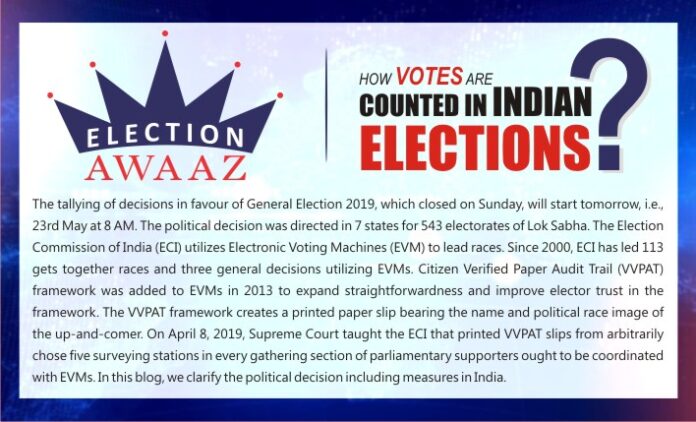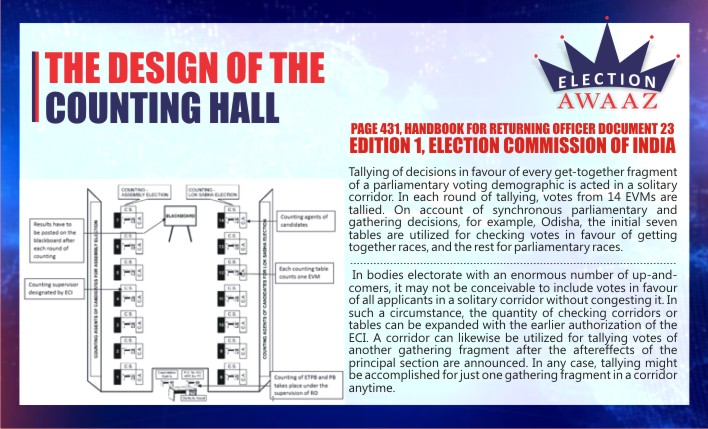The tallying of decisions in favour of General Election 2019, which closed on Sunday, will start tomorrow, i.e., 23rd May at 8 AM. The political decision was directed in 7 states for 543 electorates of Lok Sabha. The Election Commission of India (ECI) utilizes Electronic Voting Machines (EVM) to lead races. Since 2000, ECI has led 113 gets together races and three general decisions utilizing EVMs. Citizen Verified Paper Audit Trail (VVPAT) framework was added to EVMs in 2013 to expand straightforwardness and improve elector trust in the framework. The VVPAT framework creates a printed paper slip bearing the name and political race image of the up-and-comer. On April 8, 2019, Supreme Court taught the ECI that printed VVPAT slips from arbitrarily chose five surveying stations in every gathering section of parliamentary supporters ought to be coordinated with EVMs. In this blog, we clarify the political decision including measures in India.
Who is answerable for tallying the votes?
The Returning Officer (RO) is answerable for directing decisions in a voting public, which additionally incorporates checking of votes. The RO is an official of the public authority or a nearby position selected by the ECI for everybody electorate in counsel with the state government.
Where does the checking happen?
The RO chooses where the votes will be meant the parliamentary electorate. The date and season of tallying are fixed by the ECI. In a perfect world tallying of decisions in favor of supporters ought to be done in one spot, ideally at the Headquarter of the RO in that body electorate. It ought to be performed under the immediate oversight of the RO. Nonetheless, each Parliamentary Constituency has various get together sections. In the present circumstance, checking can occur at various areas for different gathering fragments under the immediate management of an Assistant Returning Officer (ARO).
The design of the Counting Hall
Page 431, Handbook for Returning Officer Document 23 Edition 1, Election Commission of India
Tallying of decisions in favour of every get-together fragment of a parliamentary voting demographic is acted in a solitary corridor. In each round of tallying, votes from 14 EVMs are tallied. On account of synchronous parliamentary and gathering decisions, for example, Odisha, the initial seven tables are utilized for checking votes in favour of getting together races, and the rest for parliamentary races.
In bodies electorate with an enormous number of up-and-comers, it may not be conceivable to include votes in favour of all applicants in a solitary corridor without congesting it. In such a circumstance, the quantity of checking corridors or tables can be expanded with the earlier authorization of the ECI. A corridor can likewise be utilized for tallying votes of another gathering fragment after the aftereffects of the principal section are announced. In any case, tallying might be accomplished for just one gathering fragment in a corridor anytime.
What is the checking cycle?
Tallying is performed by checking administrators named by the RO. Checking staff is selected through a three-stage randomization cycle to guarantee fair-mindedness. Up-and-comers alongside their tallying specialists and political decision specialists are likewise present in the checking lobby.
Tallying of votes starts with Electronically Transmitted Postal Ballots (ETPB) and Postal Ballots (PB). These votes are tallied under the immediate oversight of the RO. Checking of EVMs can begin 30 minutes after the beginning of PB tallying, regardless of whether all PBs have not been tallied. Toward the finish of each round of tallying, the outcomes from 14 EVMs are pronounced.
What is the cycle for tallying VVPAT slips?
The ECI endorses the cycle for arbitrarily choosing one EVM for everyone gets together a fragment of a parliamentary body electorate for VVPAT coordinating. The confirmation of VVPAT paper slips is led inside a protected VVPAT Counting Booth in the tallying corridor with admittance to the approved workforce as it were. Any including a table in the lobby can be changed over into VVPAT Counting Booth subsequent to finishing EVM vote tallying. Parliamentary supporters for the most part have somewhere in the range of five and ten get-together fragments.
The Supreme Court has concluded that VVPAT slips of five haphazardly chose surveying stations for every gathering section will be coordinated with the outcome that appeared in the individual EVMs. This infers that VVPAT paper slips should be coordinated for around 25-50 machines for each parliamentary voting demographic. This cycle requires the individual management of RO/ARO. The ECI has concluded that the tallying of five VVPATs will be done consecutively. The RO can proclaim the end-product for the electorate after the VVPAT coordinating cycle has been finished.
What occurs if there is a disparity between the VVPAT tally and the EVM results?
In such a case, the printed paper slip consider is taken last. The ECI has not explained whether there would be any further activity, (for example, including all VVPATs in a body electorate or get together section) if there is an inconsistency in the checks of one of the five VVPATs.















